Genre: Action Developer: Mindscape Publisher: Mindscape Players: 1 Released: 1992
I loved Outlander when I first rented the SNES version back in 1993, but I was never able to find a copy of the Genesis version to buy until 2000. Back in 1993, I loved it for how well it combined driving, shooting, and side-scrolling battling. In 2000, I loved how well it held up visually and how well it transferred to play on the Nomad, which was a treat for me, as I was trying to find just the right games to showcase on the system. Outlander was originally slated to be a Mad Max game, but the licensing rights fell through at the last minute, and the title and presumably some visuals were changed to avoid lawsuits. The game isn’t hurt at all though, as it is still what an ideal Mad Max game would be, only without the name. The core gameplay is split into two main parts: driving (which features gunplay) and side-scrolling shooting. The driving aspect is where the game truly shines.
Not only is this aspect of the game exhilarating due to all of the biker gang members terrorizing you from all sides, but you also have to avoid obstacles, such as roadblocks and roadside objects like rocks in order to keep your vehicle in drivable condition. If your car runs out of gas before you reach your destination, or sustains too much damage through enemy attacks, or the aforementioned roadside obstacles, then the game ends. Let me set the stage for you so you can get an idea as to what I’m talking about. You’ll start out a given level rather easily, just bobbing and weaving through roadblocks, then a group of bikers will come up at you. You can shoot at them in if they’re in front of your car, or to the side. If they’re in front of you, then your machine guns will blaze. If they’re beside you, then the game will open up a new gameplay window that takes up roughly 1/4th of the screen, showing your character’s arm out of the window with a gun in hand, if you line up your shots correctly, and hit an opponent, they’re done for.
When you connect with a shot, there is quite a feeling of satisfaction, not only is it hard enough to line up a shot correctly when taking into account how fast both you and your targeted foe are going, but you also have to be wary of the perils that lie ahead of you on the road, such as turns, roadblocks, etc. If you focus too much on the enemy, you’ll end up driving right through a turn and hitting some rocks, or you’ll try and react quickly, only to end up hitting a roadblock. Conversely, if you focus too much on the road’s hazards, you’ll be swarmed by enemy attacks. Finding just the right balance between the two is key to success in the game, and is rather enjoyable to do as well.
While the driving aspects are fantastic, the side-scrolling stuff doesn’t fare as well. It pits you against the biker gang folks, only all you can do is jump and shoot. That’s pretty much it, if you run out of bullets, I hope you enjoy the game over screen, because you’ll be seeing it quite a bit. This might even be tolerable if the play wasn’t so wooden, but it is, and therefore, isn’t all that tolerable. This one aspect of the game is pretty horrid, and if it didn’t have the driving stuff, the game would be God awful. Thankfully, the controls work well throughout the game though, which helps highlight the greatness of the driving, and downplay the severe weaknesses of the side-scrolling stuff.
The visuals pretty snazzy in most respects. The pre-game cinemas are full of life and detail, while the in-game visuals for the driving areas move by briskly and manage to convey a convincing sense of speed. I can’t recall any Genesis racing games beyond those made by Sega that did this, let alone any that did it as just a part of the game. Very impressive. The picture-in-picture stuff is done just as well, as the game never slows down to accommodate more action on the screen. Much like the gameplay, the side-scrolling sections are where the visual bliss pretty much ends. While things have an acceptable amount of detail, the animation for pretty much everything is bland and lifeless, as are the environments themselves, which repeat themselves quite often. All in all, I’m rather amazed that so much was done with the game visually, sure the side-scrolling stuff looks bad, but as with the gameplay, the driving portions help compensate for them.
Outlander‘s audio, unlike the gameplay and graphics, is pretty rock-solid throughout the game. It features pretty hard-hitting music, which sets a great atmosphere for the game, and adds some adrenaline to the game as well. Sound effects are done well, with everything being conveyed as it should, nothing is out of place, and nothing seems out of the realm of reality. Sure this might not seem like much, but it’s rather rare to see any game feature realistic sound effects when it could get away with not taking the time and effort to do so.
For me, this game has great sentimental value. It’s a game that I’ve enjoyed every time I’ve played it, in spite of the highly-flawed side-scrolling areas that do nothing but take away from the game. It’s still enjoyable, and holds up well against the ravages of time thanks to how well done the driving stuff was done. I’d love to see a sequel or spiritual successor to this game, and since that isn’t likely, I’m glad to at least have this gem to enjoy. Playing it on the Nomad adds a whole new dimension to the play, and the blurry screen doesn’t get in the way of things too much. There are far worse ways to spend the $5 or so this game goes for, so give it a shot if you happen upon a copy.
Some screen shots courtesy of madmaxmovies.com.
SCORE: 6 out of 10

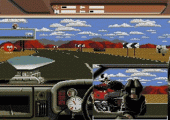
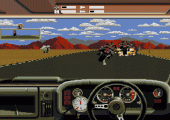
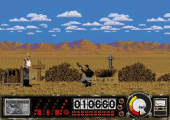
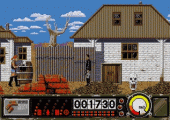
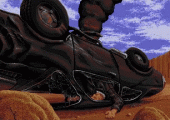
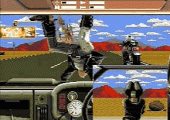
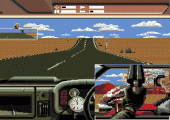
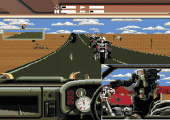
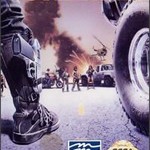
A real Mad Max game that is composed by the best Road Rash-like racing gameplay sequences and the worst T2-like gun fights I’ve ever seen. CONCLUSION: 4/10